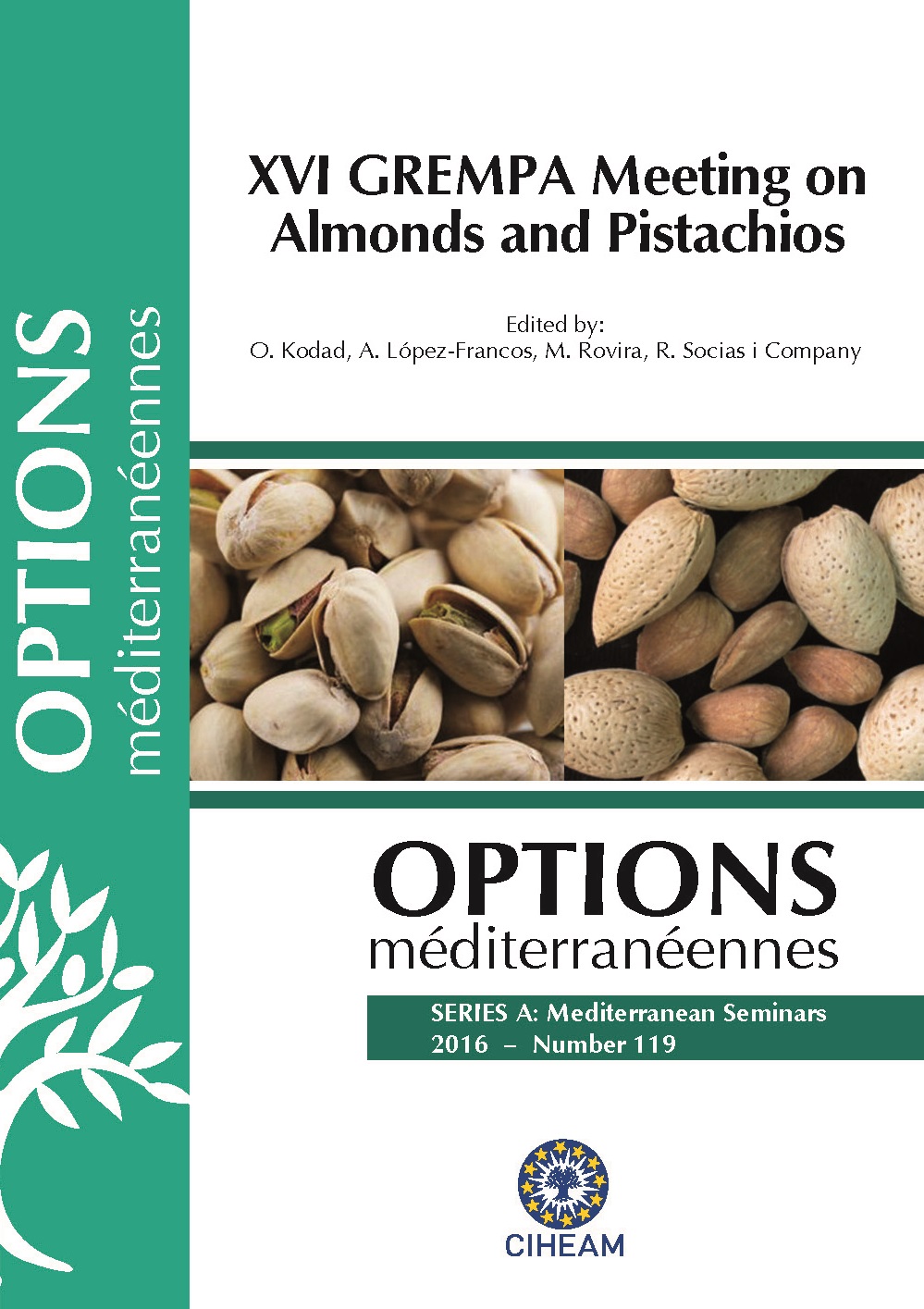| Article précédent | p. 33-36 | Article suivant |
Performance of the CITA almond releases and some elite breeding selections
Almond growing is lately increasing in Spain due to higher kernel prices and better orchard management techniques, making this crop more profitable and attractive. In addition, the release of more productive, extra-late blooming and fully autogamous cultivars, is allowing the shift of almond growing to inland areas with colder climates. The release of new cultivars must be based on their agronomic behavior under different climatic conditions. Consequently, the performance of the last commercial CITA almond cultivars (‘Guara’, ‘Soleta’, ‘Isabelona’, ‘Diamar’ and ‘Vialfas’) and some breeding selections (‘G-3-3’, ‘G-3-4’, ‘G-5-25’, ‘G-2-22’ and ‘I-3-67’) was studied in a trial at the “AFRUCCAS Experimental Fruit Farm” near Caspe (Zaragoza, Spain). The trial was established in 2005 at a distance of 6 x 7m on the peach x almond INRA GF-677 rootstock. Scions were grafted in 2006 and the trees were trained as free open vase and managed under usual commercial requirements and drip irrigation. Phenology, vigor, production, fruit and orchard parameters were controlled to ascertain the agronomical performance of each cultivar or selection. The success of any cultivar not only depends of the accuracy of the breeder’s selection, but also its adaptability must be ascertained to be recommended in a specific region.
La production d’amandier a récemment augmenté en Espagne. Les prix plus élevés de l’amande et l’amélioration des techniques de culture rendent cette production plus attractive et rentable. En plus, l’obtention de nouvelles variétés de floraison très tardive, complètement autogames et très productives ont permis l’introduction de cette culture aux zones d’intérieur de climat plus froid. L’enregistrement d’une nouvelle variété doit être basé sur son comportement agronomique dans différentes conditions climatiques. Par conséquent, le comportement agronomique des dernières variétés commerciales d’amandier du CITA (‘Guara’, ‘Soleta’, ‘Isabelona’, ‘Diamar’ and ‘Vialfas’) et de quelques sélections élite (‘G-3-3’, ‘G-3-4’, ‘G-5-25’, ‘G-2-22’ et ‘I-3-67’) a été étudié sur une parcelle expérimentale d’AFRUCCAS, près de Caspe (Saragosse, Espagne). La plantation des porte-greffe hybrides amandier x pêcher INRA GF-677 a été faite à une distance de 6 x 7 m en 2005. Les variétés ont été greffées en 2006, les arbres ont été formés comme vase libre ouvert et maintenus selon les pratiques commerciales normales de la région avec un système d’irrigation goutte-à-goutte. On a contrôlé la phénologie, la vigueur, la production, la productivité et les paramètres du fruit pour déterminer le comportement agronomique de chaque variété. Le succès d’une variété ne dépend pas seulement de la précision de la sélection de l’améliorateur, mais aussi son adaptabilité à une zone spécifique doit être évaluée pour déterminer sa convenance.
- [ Afficher ]
- [ Télécharger ]
- [ Exporter la citation ]
Vous pouvez télécharger la citation au format :
- [ Imprimer ]
-
Mots-clés
ADAPTABILITE, PRODUCTION, PRUNUS AMYGDALUS, RENDEMENT, VIGUEURCiter cet article
Alonso Segura J.M., Socias i Company R., Kodad O., Espada Carbó J.L., Andreu Lahoz J., Escartín Santolaria J. Performance of the CITA almond releases and some elite breeding selections. In : Kodad O. (ed.), López-Francos A. (ed.), Rovira M. (ed.), Socias i Company R. (ed.). XVI GREMPA Meeting on Almonds and Pistachios. Zaragoza : CIHEAM, 2016. p. 33-36. (Options Méditerranéennes : Série A. Séminaires Méditerranéens; n. 119). 16. Meeting of GREMPA (Groupe de Recherches Méditerranéennes pour l\'Amandier et Pistachier / Mediterranean Research Group for Almond and Pistachio), 2015/05/12-14, Meknes (Morocco) . http://om.ciheam.org/om/pdf/a119/00007359.pdf



